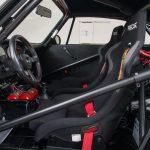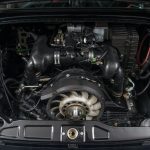The rarest of the rare. Of all of the various 911 models, the 964 pretty much leads the pack when it comes to the ultra-rare. I joke occasionally about the myriad configurations of modern 911s, which I think at this point has resulted in around 22 different model variants from which buyers can choose. There’s pretty much a variant to suit every possible need (though still no rear drive Targa, come on!). While we couldn’t really call the 964 similar it does seem to be the model where Porsche really began to see just how many different ways it could offer their flagship car. The other significant difference is that none of the current 911 models really is all that rare. There are a couple special editions that were produced in very low numbers, but those aren’t too much more than unique option packages producing cosmetic differences. Even the Turbo S Exclusive is limited to 500 and while that’s not a lot of cars it’s nothing compared to the car we have here.
This is a 1990 Porsche 911 Carrera 4 Leichtbau. According to Canepa, the sellers of this particular example, there were 22 total produced. I’ve seen that number listed elsewhere as only 20, but perhaps there were one or two additional special requests, which kind of sounds like what occurred with the one here. Like a lot of Porsche’s most extreme performance models the Carrera 4 Leichtbau wasn’t for sale in the US market. You’d almost never have a change to buy one. Here is one such chance.
CLICK FOR DETAILS: 1990 Porsche 911 Carrera 4 Leichtbau at Canepa
Year: 1990
Model: 911 Carrera 4 Leichtbau
VIN: N/A
Engine: 3.6 liter flat-6
Transmission: 5-speed manual
Mileage: 4,456 km (2,769 mi)
Price: Inquire
1991 Porsche 964 Carrera 4 Leichtbau
VIN: 964-015Porsche’s ultimate 964
One of only 22 ever produced
The only C4 Lightweight painted in black
750+ pounds lighter than a stock Carrera 4
Rally-spec all-wheel drive system built around the Porsche 953 rally car
5-speed transmission with short-ratio gearing
2769 original miles (4,456 kilometers)
Mechanical differential bias controlled from the cockpit
3.6-liter twin-plug flat six air-cooled engineIntroduced to the public in 1989, the Porsche 964 would bring technology to the 911 that was first used in the Porsche 953 rally car. All-wheel drive was now available on the 964, dubbed the Carrera 4, but added a significant weight penalty to the already-enlarged 911. With the world economy still recovering from a major recession in 1987, customer sports department manager Jürgen Barth devised a plan to revitalize customers interest by introducing a special program to produce an exclusive 964. Channeling motorsport ingenuity and engineering, Barth and his team created the most focused Porsche 964 that the world would ever see: The Porsche 964 Carrera 4 Leichtbau (Lightweight construction).
Beginning with a 964 shipped to the Weissach works factory, each of the Carrera 4 Leichtbaus were constructed in the racing factory. Upon arrival, each and every piece of the car was analyzed. If it was deemed too heavy or unnecessary, it was replaced or removed. The doors and hood were made of aluminum, the side windows Lexan, and the deck lid of lightweight plastic. The interior was stripped down to just bare paint, with a roll cage installed in its place. Racing seats were installed, a lightweight exhaust was created, the heater fan was removed and all traces of comfort and luxury were eliminated in the pursuit of lightness. When said and done, almost 770 pounds were removed from the cars. The 964 Carrera 4 Leichtbaus were true Weissach products. Built by hand and prepared like race cars, normally the adage goes “street car for the race track,” the 964 Carrera 4 Leichtbau is a true “race car for the street.”
Mechanically, the running gear became the star centerpiece which was built around the original Porsche 953 rally car. An ultra-light flywheel was paired with the short-ratio 5-speed manual transmission and using 953 all-wheel drive systems, used in the 1984 Paris Dakar rally cars, were installed into the 964s. Each drivetrain was numbered a unique set of numbers specific to each car. While the Porsche was naturally aspirated, aluminum 935 boost knobs were used to control the differential bias which could be adjusted by the driver from front to rear and side to side of the car. The stainless-steel exhaust system was fabricated and with no sound proofing or deadening materials to speak of, created one of the loudest street 911s to ever leave Germany.
With the first Leichtbau finished, the issue was now importing the 964s into the U.S. With the DOT and EPA scrutinizing all grey-market import cars, especially with Porsche after the recent influx of importing Carrera 2.7 RSs and the recent 959 program, Barth needed a way to import his new brainchild. Californian Kerry Morse committed to the first 964 Carrera 4 Leichtbau, 964-001, before they were even being built. Morse said that he would purchase several more if they ended up being built, and gave Barth’s 964 Carrera 4 Lecihtbau program its running start. Morse also pushed for the VIN to reflect the Porsche factory’s way of numbering factory werks cars to be able to import them to the U.S., and the 964s then began to receive their 964 Leichtbau-specific VINs, beginning with 964 001. These street cars had their VIN stamped the way Porsche assigned their own racecars and telling the DOT and EPA that these cars were made specifically for off-road driving. Having to stretch the truth to almost the breaking point on many parts of these special 964s in order to get the cars into the U.S. was a tricky process, but ultimately worked.
Due to internal decisions back and forth with departments, the original estimated price of $110,000 ballooned to over $170,000. Due to the 964s only being allowed to be imported as a race car in the U.S., customers had to take delivery at the Porsche factory, tacking on an additional $20,000+ in VAT fees (which could be recovered when the customer left the country). All 22 lightweight creations were sold, and Jürgen’s program made money for Porsche. Not only did it clear a path for future collectible cars from Porsche, but also made the company realize that there would always be business from loyal enthusiasts who wanted something special that no one else had.
964-015 here is the 15th example of 22 cars, special from the rest of the lineup due to its rare black paintwork. While C4 Leichtbaus were white, yellow, red and silver, this is the only car ever specified to be black. Originally purchased by Mike Amalfitano directly from the Porsche factory in 1991, the purchase would be far easier than the hurdles that the DOT and EPA in America presented. In order to get the factory racecar into the U.S., his lawyers submitted testimonies from experts of the car’s unsuitability for use on public roads, having now U.S. Senator Judd Gregg attesting to Amalfitano’s good character and honesty and personal assurances that the Porsche would only be used for competition events and not on public roads.
In August of 2010, the Lightweight would be sold from the Amalfitano collection during the Bonhams auction at the Quail Lodge and Golf Club in Carmel. Kerry Morse, a widely recognized Porsche resource and one of the original facilitators for building the Leichtbaus, purchased the car for himself. He would then sell the car to its most recent owner in 2015 and keep the car in excellent condition. Recently, the owner thought about selling the car and contacted Bruce Canepa. A personal friend of the owner, Bruce talked about the Lightweight and convinced him to bring the car to Canepa to be offered for sale.
The Carrera 4 Lightweight arrived at Canepa with its mechanicals recently serviced. Showing only 4,456 original kilometers since new, the car is close to what a new 964 Carrera 4 Lightweight would look like. The car was immediately placed into our system to be given the “Canepa Difference” process, going through the entire car cosmetically and mechanically and checking each and every system. The underside of the car was hand cleaned revealing the factory suspension and plating in pristine condition. The original black paint was carefully washed and treated to a light polish with only foam pads. With the simple interior cleaned to prepare it for our inventory, the 964 Carrera 4 Lightweight now sits ready for its new owner and to experience the raw thrill of Jürgen Barth’s lightweight masterpiece.
Leichbau means lightweight and one look at the interior of this 964 will show you the lengths Porsche went to remove weight from these cars. They are fully stripped and probably about as light as you can make a car that is road legal. The Carrera 4 was one of two 964 models to receive the Leichtbau moniker, with the other being the Turbo S based off of the 3.3 liter 964 Turbo.
The Leichtbau’s weight savings isn’t just limited to a stripped interior. Any piece that could be made lighter, was made lighter. The side windows are Lexan, the doors and hood are aluminium, the deck lid was plastic! Every creature comfort was removed from the interior. There are no carpets nor soundproofing. It has racing seats and lightweight exhaust. In all 770 pounds of weight savings were found. Being all-wheel drive the Carrera 4 always was a little heavier than your typical 911. Not this one.
This particular example has an especially unique history as it was immediately imported into the US, though only as a race car. Canepa has provided all of the details in their ad and my question is whether it’s still only usable as a race car? That, of course, assumes that an owner would spend much time driving it anyway. This one sits with fewer than 3,000 miles on the clock so it hasn’t seen a lot of time on the road or track. This also is said to be the only one of the 22 to be painted black. That almost seems hard to believe.
So how much is it worth? I’d guess at least $1.5M. While a lot of interesting 964s have been up for auction in recent years none of those has been the C4 Leichtbau. The Turbo S Leicthbau I featured earlier this year sold for $1.7M. It had little more than delivery miles on it and a lot of custom options. A more standard Turbo S Leichtbau sold in 2017 for $1.54M. There were 86 examples of the Turbo S Leichtbau produced making it four times more common than the Carrera 4. Meaning this one might cost you even more.
-Rob













I wonder how much weight was saved with the centre-cap-delete on the wheels? 🙂
Don’t buy a car from Canepa !!! They are going to raise their asking price when you are interested in the car…Been there, done that.
After a good bit of searching I did finally find out what this car sold for in 2010: $133,500. Obviously I think it’s likely worth quite a bit more today, though exactly how much I have no idea.
This is perhaps the most beautiful “modern” Porsche I’ve seen…until the next one.